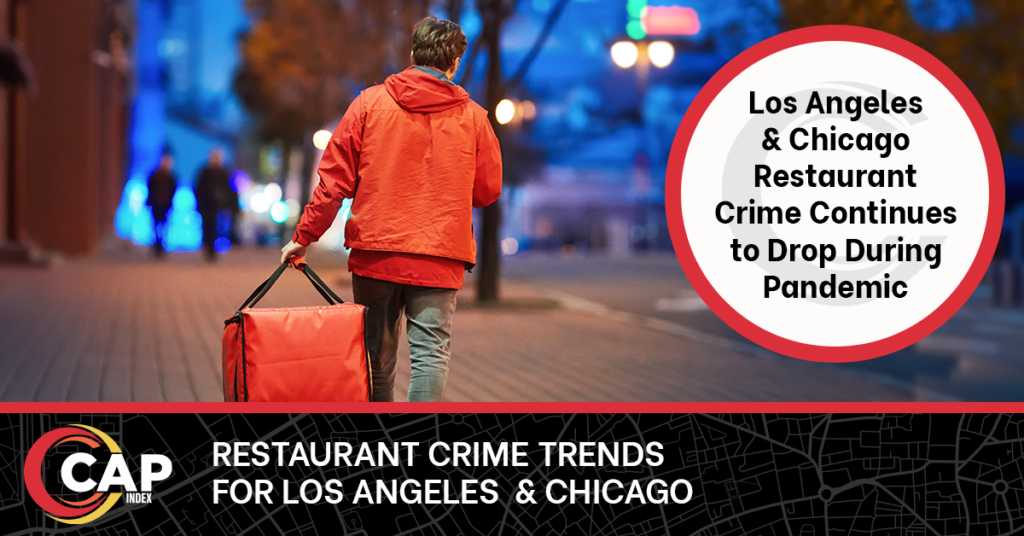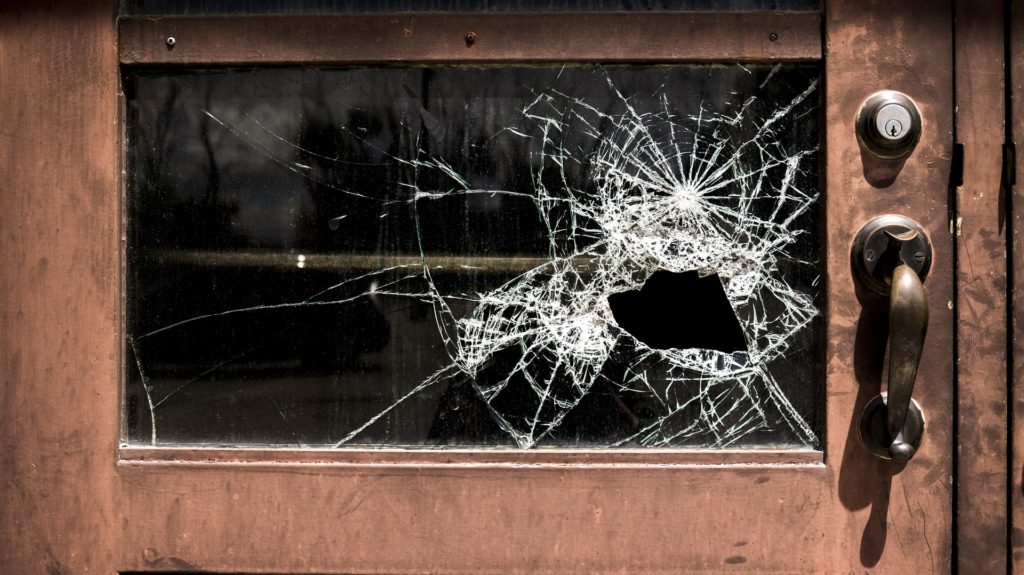COVID-19 & Crime Issue #3: Restaurant Crime in Los Angeles & Chicago
In our third issue of COVID-19 & Crime, we examine restaurant crime reported in Los Angeles and Chicago. We consulted industry experts about what they are seeing in the restaurant industry and on what might happen in the upcoming weeks and months. We would especially like to thank Van Carney, Director of Loss Prevention, Safety & Security at Domino’s for sharing his insight.
Download a PDF of this article
CRIME IN LOS ANGELES & CHICAGO DURING COVID-19
 Los Angeles and Chicago, with hundreds of COVID-19 cases reported daily, are two of the metropolitan areas hardest hit by the pandemic. Residents have been living with increasingly stringent restrictions since the middle of March, with those in Los Angeles impacted a bit earlier than those in Chicago. CAP’s Analytics team examined crime reported to the Los Angeles and Chicago Police Departments, focusing on weekly percentage changes in select crimes at restaurant establishments. Our Chicago assessment is based upon information reported for the first 28 days of March (Week 1 – Week 4). For Los Angeles, we obtained data for an additional week (Week 5, through April 4th). We provide citywide trends for comparison.
Los Angeles and Chicago, with hundreds of COVID-19 cases reported daily, are two of the metropolitan areas hardest hit by the pandemic. Residents have been living with increasingly stringent restrictions since the middle of March, with those in Los Angeles impacted a bit earlier than those in Chicago. CAP’s Analytics team examined crime reported to the Los Angeles and Chicago Police Departments, focusing on weekly percentage changes in select crimes at restaurant establishments. Our Chicago assessment is based upon information reported for the first 28 days of March (Week 1 – Week 4). For Los Angeles, we obtained data for an additional week (Week 5, through April 4th). We provide citywide trends for comparison.
LOS ANGELES ANALYSIS
The following table shows the percentage change in crime from week to week in Los Angeles from March 1st to April 4th, 2020. Note, some of the differences in this chart are based upon small counts:

Here are the key findings from Los Angeles:
- Total restaurant crime dropped by 36% from Week 1 to Week 5. Week 2 spikes preceded the substantial crime decreases that occurred in Weeks 3 and 4 when social distancing restrictions were instituted. Perhaps a floor was hit in Week 5; it will be interesting to see how crime trends in subsequent weeks. Citywide crime dropped by 28% from Week 1 to Week 5, with fairly consistent drops from week to week.
- Restaurant and citywide property crime decreases are substantial (-34% and -31%). Only Week 1 shows a significant increase for restaurants.
- The restaurant crimes against persons decrease (-14%) is less than that for all crimes (-36%) and involves periodic increases in Weeks 2 and 5. Citywide persons versus all crime differences are less significant (-23% vs. -28%), with fairly consistent decreases from week to week.
- “Other” crimes involve small numbers, so week to week fluctuations should be viewed with caution.
CHICAGO ANALYSIS
This table shows the percentage change in crime from week to week in Chicago for the month of March, 2020. Note, some of the differences are based upon small counts.

Here are the key findings from Chicago:
- From Week 1 to Week 4, total restaurant crime dropped 74%, with Week three’s 62% drop was most pronounced during that period. The city shows a more modest 35% decrease.
- The crimes against persons pattern is virtually identical to that for all crimes.
- Restaurant property crime dropped a whopping 80%, with significant decreases in Weeks 3 and 4. The city shows a more modest 33% property crime decrease.
- ”Other” crimes involve small numbers, so week to week fluctuations should be viewed with caution.
INTERPRETING THE FINDINGS – ROUTINE ACTIVITIES THEORY
As in our previous issue, we will interpret these findings and our experts’ insights in the context of criminology’s well-accepted Routine Activities Theory, which assumes that crime is likely to occur when three essential elements converge in time and space: a likely offender, a suitable target, and the absence of capable guardianship. Please note in the discussion below that various restaurant segments are being impacted differently by the pandemic. Some, like full-service dining, might be forced to close, while those with takeout and delivery services are able to flourish. All of them face new crime challenges, though.
A LIKELY OFFENDER

Our retail analysis demonstrated that, even with sheltering in place, some criminals are not intimidated by the pandemic and they continue to take advantage of limited guardianship in the COVID-19 era. Furthermore, a new type of offender may be emerging – someone with no prior criminal history – now driven by the need to provide for oneself or one’s family. How does the restaurant industry compare? Crime is mostly down for the two cities examined above. However, the first week of April showed a significant increase in crimes against persons in Los Angeles restaurants. It remains to be seen whether this is a temporary fluctuation or a persistent trend. Our experts advise that they have not seen significant changes in crime at their locations that could be attributed to the pandemic. However, they emphasize that the situation is changing rapidly and new trends may be starting to emerge in select areas of the country. For instance, some offenders are beginning to take advantage of closed locations and burglaries are spiking in some markets. Other criminals are starting to realize the benefit of more recent orders to wear masks. While face coverings are intended to help reduce the spread of the virus, they also help conceal identity. Our experts caution about the impact this might have on in-store robberies.
A SUITABLE TARGET
Many restaurants continue to operate in the COVID-19 era, while some have closed. However, for those still open, business is definitely not as usual. Modified hours, dining room closures, and shifts to drive-through or delivery operations are some of the dramatic operational changes necessitated by the pandemic. Closed locations are targets for burglary. While we have not found increases in burglary for Chicago or Los Angeles yet, our experts report upward trends in some metropolitan areas, including Houston. They also raised concerns about drive-thru assaults and robberies, especially with increasingly agitated customers. Delivery drivers are now potential targets more than ever, and our practitioners mentioned increases in delivery robberies in some areas of the country. Furthermore, given that restaurants often are the only businesses operating in an area, they are increasing magnets for the homeless population and the issues that extend from that. Finally, with changed access to the usual targets of crime, our experts are concerned about a potential displacement to other types of crime, such as scams, including loyalty program or coupon fraud.
GUARDIANSHIP

In our previous issue, we emphasized the importance of guardianship and the current concerns associated with the lack thereof, in the COVID-19 era. However, our restaurant industry experts share a more positive outlook on this subject. Even though law enforcement resources have been impacted by sickness and changes in response protocols, they continue to support local restaurants. To give an example, one of our practitioners states that the police have been very effective in managing disorder associated with the homeless population influx mentioned earlier. These successes vary by area and are somewhat dependent upon law enforcement partnerships. Our experts strongly emphasize the benefit of building such relationships.
FINAL THOUGHTS
Given the principles of the Routine Activities Theory, increases in likely offenders, plenty of suitable targets, and some decreases in guardianship could set the stage for major crime increases. What should restaurants be doing differently to address this challenge?
Our experts stress the importance of monitoring trends daily and adjusting responses accordingly. They strongly emphasize the value of employee training and regular communication. With webinars conducted as often as twice a week, our practitioners credit their success in response to the pandemic to constant training of their employees. As far as mitigating some of the emerging concerns, like the increase in delivery driver robberies, restricting delivery in certain areas or engaging law enforcement to make deliveries might be considered in extreme circumstances. Contactless delivery might be implemented to protect the safety and security of drivers and customers. Finally, our experts recommend utilizing proven resources like crime risk data from CAP, local law enforcement statistics, and regular communication with industry peers, which is especially important in this rapidly evolving environment.
CAP’s Analytics team continues to assist the industry with information sharing. We suspect that a lot of restaurant crimes do not get reported to the police, which is why it is important to gather information directly from the source. That is why CAP is once again partnering with the Restaurant Loss Prevention and Security Association (RLPSA) to gather timely data from the members and study emerging trends for major metropolitan areas. Stay tuned for more information from the RLPSA regarding this initiative.
Article by: Basia Pietrawska, VP, Consulting & Analytics – Steven K. Aurand, President & CEO – Walter E. Palmer, Executive Vice President
Download a PDF of this article
 Sample CRIMECAST Reports
Sample CRIMECAST Reports